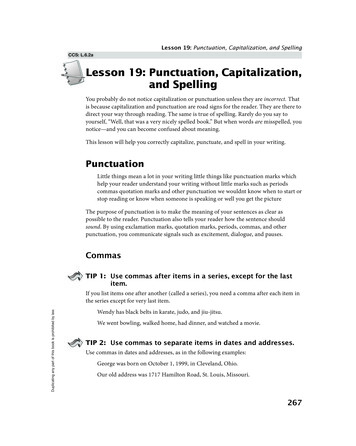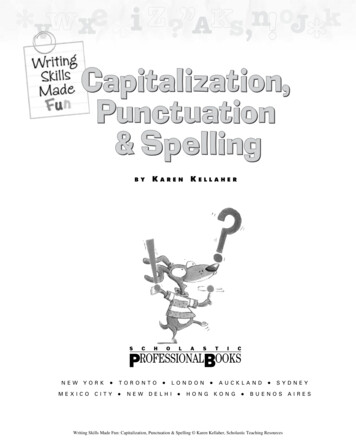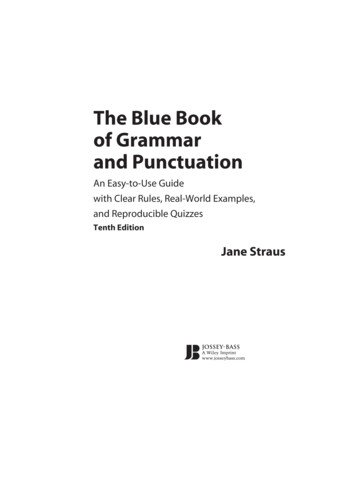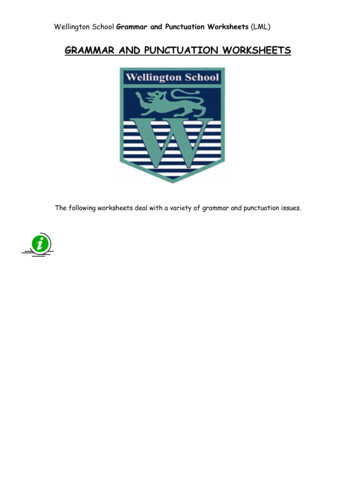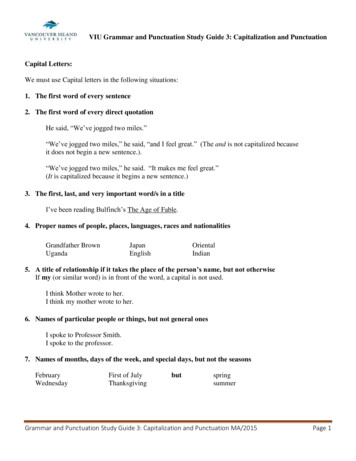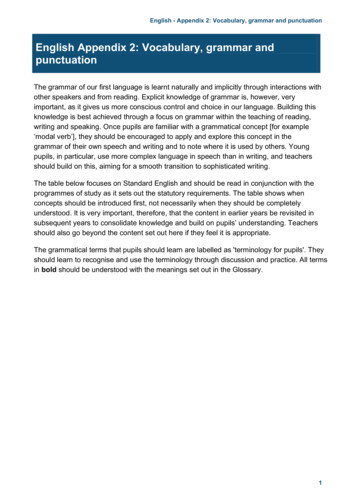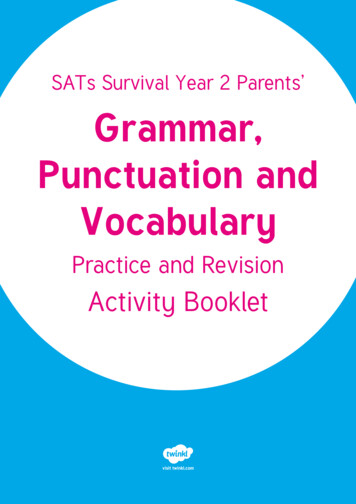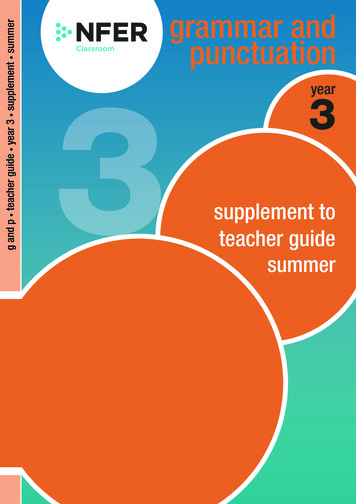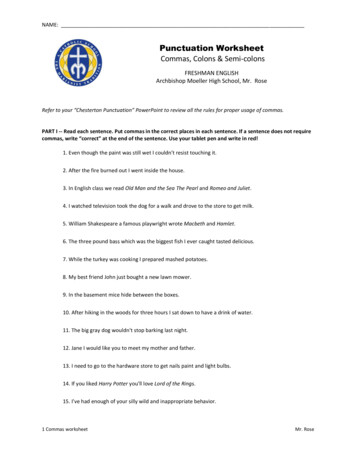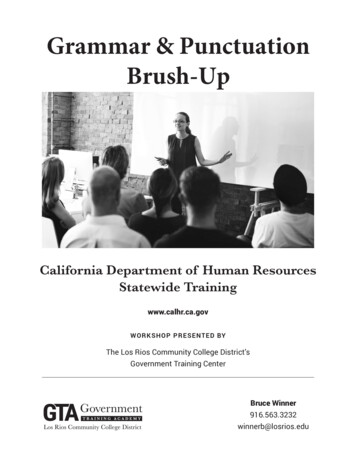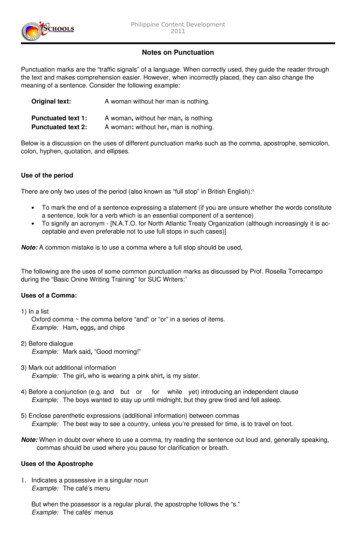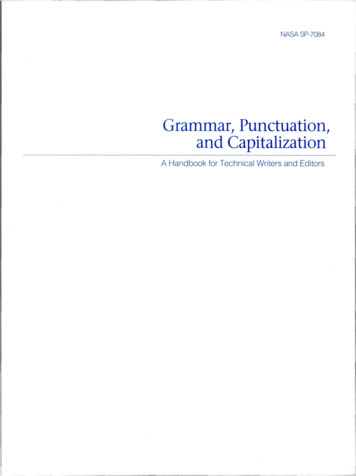
Transcription
NASA SP-7084GraIllIllar, Punctuation,and CapitalizationA Handbook for Technical Writers and Editors
NASA SP-7084Grammar, Punctuation,and CapitalizationA Handbook for Technical Writers and EditorsMary K. McCaskillLangley Research CenterHampton, VirginiaNJ\S/\National Aeronautics and Space AdministrationOffice of ManagementScientific and Technical Information DivisionWashington, DC1990
PrefaceThe four chapters making up this reference publication were originallywritten as part of an ongoing effort to write a style manual for the TechnicalEditing Branch of the NASA Langley Research Center. These chapters werewritten for technical publishing professionals (primarily technical editors)at Langley. At the urging of my branch head, I am making this part of thestyle manual available to the technical publishing cQmmunity.This publication is directed toward professional writers, editors, andproofreaders. Those whose profession lies in other areas--(for example,research or management), but who have occasion to write or review others'writing will also find this information useful. By carefully studying theexamples and revisions to these examples, you can discern most of thetechniques in my editing "bag of tricks"; I hope that you editors will findthese of particular interest.Being a technical editor, I drew nearly all the examples from the documents written by Langley's research staff. I admit that these examplesare highly technical and therefore harder to understand, but technical editors and other technical publishing professionals must understand grammar,punctuation, and capitalization in the context in which they work.In writing these chapters, I came to a realization that has slowly beendawning on me during my 15 years as a technical editor: authorities differon many rules of grammar, punctuation, and capitalization; these rules areconstantly changing (as is our whole language); and these rules (when theycan be definitely ascertained) sometimes should be broken! Thus muchof writing and editing is a matter of style, or preference. Some of theinformation in this publication, particularly the chapter on capitalization,is a matter of style. Langley's editorial preferences are being presented whenyou see the words we prefer, "we" being Langley's editorial staff. I do notintend to imply that Langley's style is preferred over any other; however, ifyou do not have a preferred style, Langley's editorial tradition is a long andrespected one.I wish to acknowledge that editorial tradition and the people whoestablished it and trained me in it. I am also grateful to Alberta L. Cox,NASA Ames Research Center, and to Mary Fran Buehler, Jet PropulsionLaboratory, for reviewing this document.iii
11111111111111111111111111111111
ContentsPreface . . . . . . . . . . . . . . . . . . . . . . . . . . .1. (jrananaar. . . . . . . . . . . .11111.1. Grammar and Effective Writing11.2. Nouns . . . . . . . . . . . .11.2.1. Possessive Case . . . . . .1.2.2. Possessive of Inanimate Objects1.3. al PronounsRelative Pronouns .Demonstrative Pronouns1.4. Verbs . .1.4.1.1.4.2.1.4.3.1.4.4.2234578TenseMoodVoiceVerb Number81010111.5. Adjectives . . .121.5.1. Articles1.5.2. Unit Modifiers13141.6. Adverbs . . . . .161.6.1. Misplaced Adverbs1.6.2. Squinting Adverbs .1.6.3. Split Infinitives1. 7. Prepositions. . . . .161717171. 7.1. Prepositional Idioms1.7.2. Terminal Prepositions1. 7.3. Repeating Prepositions .1818181.8. Conjunctions . . . . . . .191.8.1. Coordinating Conjunctions1.8.2. Subordinating Conjunctions1920221.9. Verbals1.9.1. Coordinate Gerunds and infinitives1.9.2. Idiom Requiring Gerund or Infinitive1.9.3. Dangling Verbals . . . . . . . . .v222223
2. Sentence Structure272.1. Sentence Structure and Effective Writing272.2. Subjects and Verbs . . .272.2.1. Clarify Subject . . .2.2.2. Make Verbs Vigorous2.2.3. Improve Subject-Verb Relationship2729312.3. Parallelism. . . . . . . . . . . .332.3.1. Connectives Requiring Parallelism2.3.2. Itemization . . . .33342.4. Brevity and Conciseness352.4.1. Wordiness2.4.2. Shortening Text .2.4.3. Shortening Titles352.5. Comparisons . . . .392.5.1. Comparison of Adjectives and Adverbs.2.5.2. Ambiguous Comparisons .2.5.3. Comparison Constructions2.6. Emphasis3737394041432.6.1. Emphasizing With Sentence Structure2.6.2. Emphasizing With Punctuation . . .43453. Punctuation . . . . . . . . . . . . .473.1. A Functional Concept of Punctuation473.2. Apostrophe473.3. Brackets483.4. Colon .483.4.1. Colons That Introduce3.4.2. Conventional Uses of the Colon3.4.3. Use With Other Marks.3.5. Comma . . . . . . . . .3.5.1.3.5.2.3.5.3.3.5.4.Commas That SeparateCommas That Enclose .Conventional Uses of the CommaUse With Other Marks. . . . .VI4851515151565960
3.6. Em Dash3.6.1.3.6.2.3.6.3.3.6.4.60Dashes That EncloseDashes That SeparateConventional Uses of the DashUse With Other Marks .616263633.7. En Dash.633.8. Hyphen .64Word :PivisionPrefixes . . .SuffixesCompound Words646465653.9. Italics . . . . . . .3.9.5.3.9.6.3.9.7.Italics for EmphasisItalics for Special TerminologyItalics for Differentiation . .Italics for Symbology . . . .Conventional Uses for Italics .Italics With Typefaces Other Than RomanItalics With Punctuation676868696970703.10. Parentheses703.11. Period . .713.11.1. Abbreviations3.11.2. Conventional Uses of the Period3.11.3. Use With Other Marks7272733.12. Points of Ellipsis .733.13. Question Mark743.14. Quotation Marks753.14.1. Quoted Material3.14.2. Words Requiring Differentiation3.14.3. Use With Other Marks3.15. Semicolon. . . . . .3.15.1.3.15.2.3.15.3.3.15.4.3.15.5.Coordinate ClausesSeries . . . . . .Explanatory Phrases and Clauses.Elliptical Constructions'Use With Other Marks3.16. Slash . . . . . . . . . .vii75767777777879797980
4. Capitalization .814.1. Introduction814.2. Sentence Style encesQuotationsQuestionsLists. . .Stylistic Uses for Sentence Style Capitalization82828383844.3. Headline Style Capitalization844.4. Acronyms and Abbreviations854.4.1. Capitalization With Acronyms4.4.2. Capitalization of Abbreviations4.5. Proper Nouns and Adjectives ersonal Names and TitlesGeographic NamesAdministrative Names . .Names of Public Places and InstitutionsCalendar and Time DesignationsScientific NamesTitles of Works . . .Miscellaneous ndex . .101Vlll
Chapter 1. Grammar1.1. Grammarand EffectiveWritingAll writing begins with ideas that relate to one another. An author chooseswords that express the ideas and chooses an arrangement of the words(syntax) that expresses the relationships between the ideas. Given thisarrangement of words into phrases, clauses, and sentences, the author obeysgrammar and punctuation rules to form a series of sentences that will impartthe ideas.English rules of grammar originated in antiquity, but over centurieshave evolved according to usage and are still changing today. Thus, grammar rules may change and may be inconsistent, but usually have a functional basis. This functional attitude toward grammar, and punctuation, isdescribed in Effective Revenue Writing 2 (Linton 1962). A rule of grammaror punctuation with a functional basis will not prevent effective statementof ideas, nor will following all the rules ensure effective writing.Effective writing requires good syntax, that is, an effective arrangementof sentence elements. Obviously, an editor is responsible for ensuringthat a consistent and correct set of grammar and punctuation rules havebeen applied to a report (a process often called copy editing). However,language and substantive edits, as defined by Van Buren and Buehler (1980),involve revision of sometimes perfectly grammatical sentences to improveeffectiveness of sentence structure. This chapter discusses grammar, andthe next chapter concerns sentence structure with emphasis on methods ofrevision.According to Webster's Ninth New Collegiate Dictionary, grammarmeans "the study of the classes of words, their inflections [changes inform to distinguish case, gender, tense, etc.], and functions in a sentence."An abundance of good, detailed grammar, writing, and usage books areavailable. This chapter is not meant to be a definitive grammar reference. Itis intended to address grammatical problems often encountered in technicaldocuments and to indicate preference when grammar authorities do notagree. Please refer to the books cited in the References section and othersto complement and clarify the discussions that follow.1.2. NounsNouns change form to indicate case. and number. The number of anoun is usually not a problem (though the number of pronouns and verbscorresponding to the noun may be). The three possible cases are nominative,objective, and possessive. In English, nominative and objective case nounshave the same form.
Chapter 1. Grammar1.2.1. Possessive CaseAt Langley, the preferred rules for forming possessives are as follows (G.P.O.1984; and Rowland 1962): Form the possessive of a singular or plural noun not ending in s byadding's. Form the possessive of a singular or plural noun ending in s by adding anapostrophe oneses' Form the possessive of a compound noun by adding's to the end of thecompound:sister-in-Iaw's homeJohn Doe, Jr.'s reportpatent counsel's decision Indicate joint possession by adding's to the last element of a series; indicateindividual possession by adding's to each element:Wayne and Tom's office (one office)editor's, proofreader's, and typist's tasksSome authorities (for example, Skillin et al. 1974; and Bernstein 1981)partially disagree with the second rule above. They state that the possessiveof a singular proper noun is formed by adding's even when the noun endsin s (for example, Jones's); however, a triple sibilant is always avoided (forexample, Jesus').1.2.2. Possessive ofInanimateObjectsIn the past, the possessive case ('s) was not acceptable for inanimate nouns.Instead the preposition of was preferred, that is, strength of the laminaterather than laminate's strength.Exceptions to this rule were inanimate words representing a collectionof animate beings (for example, company's profits, university's curriculum)and words expressing measure or time (for example, 2 hours' work). Currentpractice is to dispense with both the's and the of (Skillin et al. 1974):company profitsuniversity curriculumlaminate strength2 hours work2
Section 1.3. PronounsIn fact, the use of's on an inanimate object is no longer taboo,particularly if the object has some lifelike qualities (Bernstein 1981):computer program's nameEarth's rotationWhether an's can properly be added to an inanimate noun seems tobe a matter of idiom. We would not say, for example,systems' analysttable's top1.3. PronounsAll pronouns must have an antecedent (the noun they replace) with whichthey agree in number, gender, and person. In addition, some pronounschange form to indicate nominative, objective, and possessive case (forexample, he, him, his). An apostrophe is never used to form possessive case pronouns .1.3.1. AntecedentsMost grammatical errors involving pronouns result from the lack of a clearantecedent. The following sentences suffer from this problem:He foresaw aircraft applications and thus emphasized rectilinear motions.This causes complicated integral equations for other types of motion.The boundary condition becomes a source term, which permits use of theGreen function.Required surface pressures are obtained in several ways, for example,from blade element theory or experimental measurements. Whatever thetechnique, it is usually available.In the first two sentences the pronouns this and which refer to the idea ofthe previous sentence or clause and do not have a noun antecedent. TheWriter's Guide and Index to English (Ebbitt and Ebbitt 1978) states thatthis "broad reference" usage of pronouns is acceptable in "general" writing,but should be avoided in "formal" writing. The danger of broad referenceis that the antecedent (whether a noun or a clause) may not be clear. Inthe second sentence above, which appears to refer to term. The followingrevisions would be preferable:He foresaw aircraft applications and thus emphasized rec ilinear motion.This emphasis causes complicated integral equations for other types ofmotion.Because the boundary condition becomes a source term, the Greenfunction can be used.In the third sentence, it is much too distant from its antecedent, pressures.Because of this distance, the pronoun does not agree in number with itsantecedent.3
Chapter 1. GrammarBernstein (1981) discusses ambiguous or nonexistent antecedents under"Pronouns" and under particular words, for example, "Each" and "None." Grammatical errors involving pronoun antecedents can be avoided verysimply: check every pronoun for a clear, appropriate antecedent and thenensure agreement between antecedent and pronoun.1.3.2. PersonalPronounsFirst person pronounsTichy and Fourdrinier (1988) attribute the pervasiveness of passivevoice in technical writing to evasion of first person pronouns (/, we). In theearly 1900's, first person pronouns were banished from technical writing toobtain objectivity; however, Tichy and Fourdrinier effectively demonstratethat objectivity is not always attained. Writing authorities no longer forbid,and sometimes encourage, the use of first person pronouns (CBE 1978; AlP1978; Houp and Pearsall 1984; and Mills and Walter 1978). Thus, we intechnical documents cannot be condemned, particularly when the opinionof the author (and a research staff) is being expressed:We believe that this effect is due to nozzle aspect ratio.This use of we, meaning "I and others," should be distinguished fromthe editorial we, meaning "you readers and I" (Ebbitt and Ebbitt 1982).In technical documents the editorial we is often used in mathematicalpresentations:Now we define a recursive relation for the (k l)th iteration:Tichy and Fourdrinier (1988) recommend that the antecedent of we alwaysbe made clear. They also offer advice on when to use first person pronounsand when not to.GenderThird person singular pronouns change form to indicate gender (he,she). When the pronoun could refer to either sex or when the antecedent'ssex is unknown, the masculine pronoun is grammaticaL However, in recentyears, objections have been raised to this grammatical rule. It is preferred practice to avoid the masculine pronoun when the antecedentmay be feminine. Often the antecedent can be made plural:PoorBetter4An editor must have guidelines on which to base hisrevisions.Editors must have guidelines on which to base theirrevisions.
Section 1.3. PronounsOr the wording of the sentence can be changed:PoorBetter1.3.3. RelativePronounsThe listener may not fully perceive the sound becausehis ear has a critical summation time of 1 sec.The listener may not fully perceive the sound becausethe human ear has a critical summation time of 1 sec.Relative pronouns function not only as pronouns but also as conjunctions.The relative pronoun replaces a noun in a dependent clause and connectsthe clause to the rest of the sentence.Antecedents of relative pronouns Who and whom refer to persons. Which refers to things. That refers to things and in rare instances may refer to persons. Whose, the only possessive case relative pronoun, may refer to either personsor things according to Bernstein (1981). Other grammar authorities disagreeand condemn the use of whose to refer to inanimate nouns. We prefer whosewhen of which would be awkward:AwkwardA low-cost process has been developed for making alumina, the limited availability and cost of which havepreviously inhibited its widespread use.BetterA low-cost process has been developed for making alumina, whose limited availability and cost have previously inhibited its widespread use.AwkwardThe attenuation is accompanied by an echo the amplitude of which is above the background level and theposition of which is related to the depth of the region.BetterThe attenuation is accompanied by an echo whoseamplitude is above the background level and whoseposition is related to the depth of the region.Which versus that Which is always used in a nonrestrictive relative clause (one that could beomitted without changing the meaning of the basic sentence):The most common examples of panel methods are the aerodynamic codesof Hess and Smith (ref. 26), which were originally developed for nonliftingsurfaces.Which may also be used in a restrictive relative clause. Note that properpunctuation of restrictive and nonrestrictive clauses is vital: commas enclosenonrestrictive clauses, but never enclose restrictive clauses (see section3.5.2).5
Chapter 1. Grammar That is preferred for restrictive (or defining) relative clauses (Bernstein1981):The most common examples of panel methods are the aerodynamic codesthat Hess and Smith (ref. 26) designed for nonlifting bodies.There are three exceptions to the use of that to introduce a restrictive clause: Which must be used after a preposition (Bernstein 1981):The shading in figure 2 indicates elements in which fibers have failed. Which is used after the demonstrative that (Bernstein 1981):The most commonly used aerodynamic code is that which Hess and Smith(ref. 26) designed for nonlifting bodies. Which sounds more natural when a clause or phrase intervenes between therelative pronoun and its antecedent (Fowler 1944):Finite bodies can undergo motions (such as spinning) which complicatethe equations.Omission oj thatThat can sometimes be omitted from restrictive relative clauses, butthis omission is not recommended:CorrectBetterThe model they analyzed is the most realistic onestudied.The model that they analyzed is the most realistic onestudied.Who versus whomWho (and its indefinite derivative whoever) is the only relative pronounthat changes form to indicate case (who, whom, whose). When a relativeclause is inverted, we have difficulty determining whether the pronoun isin nominative case (who) or in objective case (whom). The easiest way toresolve such questions is to change the relative clause to an independentclause by substituting a third person personal pronoun for the relativepronoun. For example, in the questionable sentenceInformation derived from this contract may be transmitted to those whothe Defense Department has cleared to receive classified information.change the relative clause to an independent clause:The Defense Departmenttion.h scleared them to receive classified informa-The sentence requires a third person pronoun in objective caf:je (them), sothe relative pronoun must also be in objective case ( . those whom theDefense . ).6
Section 1.3. Pronouns1.3.4. DemonstrativePronounsDemonstrative pronouns refer to something present or near (this, these) orto something more remote (that, those). Technical writing tends to exhibittwo types of problems involving demonstrative pronouns: broad reference(see section 2.2.1) and incomplete comparison (see section 2.5.2).Broad referenceThe demonstrative this is often used to refer to the idea expressed inthe previous sentence, a practice to be avoided in formal writing (Ebbittand Ebbitt 1982). For example,The entire noise prediction methodology for moving bodies becomesautonomous. This means that improved models can be incorporatedsimultaneously in pressure and noise calculations.Most loads could be reduced 0.8 percent if voltage was more closelyregulated. Nonessential loads such as payloads could take advantage ofthis, but essential loads could not.This type of construction is sometimes vague and usually unnecessary. Oftenthe demonstrative pronoun can be deleted:The entire noise prediction methodology for moving bodies becomesautonomous. Thus, improved models can be incorporated simultaneouslyin pressure and noise calculations.Or the antecedent can be clarified:Most loads could be reduced 0.8 percent if voltage was more closelyregulated. Nonessential loads such as payloads could take advantage ofvoltage regulation, but essential loads could not.Incomplete comparisonDemonstrative pronouns can often be used to complete vague comparisons:PoorBetterThe errors in this prediction are greater than in table III.The errors in this prediction are greater than those intable III.But make sure that the antecedent and meaning are clear:UnclearWest's results were in better agreement with ours thanthose of Long et al.EitherWest's results were in better agreement with ours thanwere those of Long et al.OrWest's results were in better agreement with ours thanwith those of Long et al.See section 2.5 for further discussion of comparisons.7
Chapter 1. Grammar1.4. VerbsVerbs, the only words that can express action, change form to indicateperson, tense, mood, voice, and number.1.4.1. TenseVerbs change form to indicate tense, or time that an action or state ofbeing takes place. English has six tenses: present, present perfect, past,past perfect, future, and future perfect. Each of the six tenses has aprogressive form indicating a continuing action. (See Text 4 of EffectiveRevenue Writing 1, IRS 1962.) Writing authorities do not specify exactlywhich tenses should be used in a technical document, but they universallyagree that shifts in tense should occur only when the time of the actionchanges. In other words, the point of view of a report with respect to tensemust be consistent.The relationship between point of view and verb tense can be understood in terms of the four elements of discourse (Buehler 1970): Exposition (explains how and why things happen) Narration (tells what happened) Description (gives a mental image) Argumentation (convinces by reasoning)The elements are quite often mixed. For example, in the Results and Discussion section, behavior of models or specimens (narration) might be discussed along with presentation of results in tables and figures (description)and explanation of results (exposition). Narration is usually in past tensewhile description and exposition are usually in present tense. Consistencyin tense does not mean that all sentences are in the same tense; it meansthat sentences expressing the same point of view (or element of discourse)are in the same tense. A void shifting back and forth between points of viewby grouping material with a consistent viewpoint; but when the viewpointdoes shift, shift the tense accordingly.Tenses of independent clauses of reportThere are no firm rules concerning tense of various sections in a report.However, if an author is inconsistent in tense, the following guidelines mightbe helpful to the editor: The Summary is usually in past tense. Past research (for example, in references) is usually described in past tense. Permanent facilities are usually described in present tense. Experimental procedures and apparatus for a particular study are usuallydescribed in past tense.8
Section 1.4. Verbs Behavior of models, specimens, etc., during the study is usually expressedin past tense, and results presented in the report's illustrative material areexpressed in present tense:Typical fracture profiles are shown in figure 21. These profiles show thatfracture mode changed with cyclic exposure. The specimens failed .As shown in figure 10, the autorotative rolling moment is a nonlinearfunction of roll rate, so that as spin rate increased, the propellingmoments became equal. Explanation of why results occurred are in present tense:The data failed to provide any reasonable estimates for enT This failurecan be attributed to the small excitation of yawing velocity. The Concluding Section is usually in past tense except that conclusions (thatis, deductions thought to be universally true independent of the specificconditions of the investigation) should be in present tense. The Abstract is usually in present tense.Sequence of tensesThe logical time relation between the various verbs and verbals in asentence is expressed by shifts in the tense of these verbs and verbals.Sequence of tenses is a very complicated subject, which is discussed in almostevery grammar and writing book. Only the basic guidelines are given here;for a more complete understanding, refer to such reference books. When the principal verb is in a present or future tense, subordinate verbsmay be in any tense:The data indicate that lift increases with angle of attack up to a 35 .The data indicate that the specimen failed in a noncumulative mode.The data indicate that propellers will have a place as a propulsive deviceof the future. When the principal verb is in a past tense, the subordinate verb must be ina past tense unless the subordinate clause expresses a universal truth or anaction that is still continuing:The data indicated that lift increased with angle of attack up to a 35 .Previous studies had indicated that. alumina is a suitable fiber forreinforcement. The present tense forms of verbals refer to action occurring at the sametime as the main verb; the past tense or perfect tense forms of verbals refer9
Chapter 1. Grammarto action occurring before the action of the main verb. This principle ismost easily seen for participles:Photographs indicating nearly laminar flow justified this assumption.Photographs taken during an earlier test justified this assumption.1.4.2. MoodThe three moods in English are indicative, imperative, and subjunctive.Almost all verbs in technical documents are indicative. Imperative mood issometimes used in instructions or descriptions of procedures. Subjunctivemood is rarely used and seems to be disappearing from English usage.However, there are two situations when the subjunctive should be used(Bernstein 1981): Subjunctive mood is used to indicate a command, suggestion, recommendation, or requirement:The console operator instructed that the preflight inspection be repeated.The committee recommends that this research be continued. Subjunctive mood is used to indicate a condition contrary to fact or highlyimprobable:If the integral were not singular, the question could be solved easily.Up to now, all discontinuous fiber-reinforced composites have low ductility. If their ductility were improved, they would be highly attractivematerials for aircraft applications.The subjunctive should be used only when the author wishes to imply strongdoubt. Notice the subtle change in attitude when the subjunctive is not usedin the above example:If their ductility was improved, they would be highly attractive materialsfor aircraft applications.1.4.3. VoiceThe voice of a verb indicates whether the subject is performing the action(active) or receiving the action (passive). Writing authorities overwhelmingly prefer active voice because it is direct, clear, and natural. Overuse ofpassive voice weakens style and obscures responsibility. This preference foractive voice is not a condemnation of passive voice. Tichy and Fourdrinier(1988) list five situations when the passive voice is appropriate: When the actor is unimportant, not known, or not to be mentioned When the receiver of the action should be emphasized When the sentence is abrupt in active voice When variety is needed in an active voice passage10
Section1.4.Verbs When a weak imperative is needed (for example, "The figures should becorrected quickly")The first two items justify much of the passive voice in technical documents.See section 2.2.2 for a discussion of revising passive voice sentences to makethem active voice.1.4.4. Verb NumberA verb must agree in number with its subject. This is a simple andabsolute rule. However, verb-noun disagreements (in number) are commongrammatical errors, sometimes caused by words intervening between thesubject and verb and sometimes caused by difficulty in determining thenumber of the subject. Some nouns have confusing singular or plural forms, for example,aeronautics, sing.apparatus, sing.apparatuses, pI.data, pl.1equipment, sing.hardware, sing.phenomena, pI.criteria, pI.Consult the dictionary or a usage book when there is a question concerningthe number of a particular noun.Subjects joined by coordinate conjunctions Subjects joined by and, whether singular or plural, require a plural verb. Singular subjects joined by or or nor require a singular verb. When a singular subject and a plural subject are joined by or or nor, theverb agrees in number with the subject nearer to it. When subjects are joined by and/or, the number of the verb depends on theinterpretation of and/or. Either a singular or plural verb can be justified.Bernstein (1981) considers and/or a "monstrosity" and recommends that itbe avoided. Often either and or or alone is sufficient.Subjects with intervening phrasesPhrases that intervene between the subject and verb do not affect thenumber of the verb; it aiways agrees with the subject:Damping ratio as well as frequency agrees with the experimental values.This error plus any other systematic errors appears in the output of theinstrument.1 Authorities disagree on the number of the noun data. Bernstein (1981) takes thetraditional view that it is a plural noun, but Tichy and Fourdrinier (1988), Ebbitt andEbbitt (1982), and IRS (1962) consider it to be a collective noun either singular or pluraldepending on its meaning. We prefer that data be plural in Langley reports.11
Chapter 1. GrammarCollective subjectsA singular collective subject, which names a group of people or things,is treated as singular when the group is considered a unit or as plural whenthe members of the group are considered individually:Langley's research staff is well-known for its achievements in aeronautics.Langley's research staff do not all publish their results in report form. The number of such words as most, all, some, half, part, or percent isgoverned by the num
grammar and punctuation rules to form a series of sentences that will impart the ideas. English rules of grammar originated in antiquity, but over centuries have evolved according to usage and are still changing today. Thus, gram mar rules may change and may be inconsistent, but usually have a func tional basis.Cited by: 9Publish Year: 1990Author: Mary K. McCaskill
